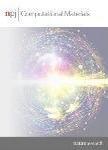Spin–spin interactions in defects in solids from mixed all-electron and pseudopotential first-principles calculations
作者机构:Department of Mechanical EngineeringUniversity of MichiganAnn ArborMIUSA Pritzker School of Molecular EngineeringUniversity of ChicagoChicagoILUSA Department of ChemistryUniversity of ChicagoChicagoILUSA Department of Materials Science and EngineeringUniversity of MichiganAnn ArborMIUSA Materials Science DivisionArgonne National LaboratoryLemontILUSA
出 版 物:《npj Computational Materials》 (计算材料学(英文))
年 卷 期:2021年第7卷第1期
页 面:1108-1115页
核心收录:
学科分类:07[理学] 070203[理学-原子与分子物理] 0805[工学-材料科学与工程(可授工学、理学学位)] 0701[理学-数学] 0801[工学-力学(可授工学、理学学位)] 0702[理学-物理学] 0812[工学-计算机科学与技术(可授工学、理学学位)]
基 金:K.G.and V.G.are grateful for the support of the Department of Energy,Office of Basic Energy Science,through grant number DE-SC0017380,under the auspices of which the computational framework for FE based AE DFT calculations was developed M.O.and G.G.are grateful for the support from AFOSR FA9550-19-1-0358 under which applications to spin defects were developed H.M.and G.G.are grateful for the support from MICCoM,under which code development was supported.MICCoM is part of the Computational Materials Sciences Program funded by the U.S.Department of Energy,Office of Science,Basic Energy Sciences,Materials Sciences and Engineering Division through Argonne National Laboratory,under contract number DE-AC02-06CH11357 This work used computational resources from the University of Michigan through the Greatlakes computing platform,resources from the Research Computing Center at the University of Chicago through UChicago MRSEC(NSF DMR-1420709) resources of the National Energy Research Scientific Computing Center(NERSC),a U.S.Department of Energy Office of Science User Facility operated under Contract No.DE-AC02-05CH11231
主 题:dynamics solids Hamiltonian
摘 要:Understanding the quantum dynamics of spin defects and their coherence properties requires an accurate modeling of spinspin interaction in solids and molecules,for example by using spin Hamiltonians with parameters obtained from first principles *** present a real-space approach based on density functional theory for the calculation of spin-Hamiltonian parameters,where only selected atoms are treated at the all-electron level,while the rest of the system is described with the pseudopotential *** approach permits calculations for systems containing more than 1000 atoms,as demonstrated for defects in diamond and silicon *** show that only a small number of atoms surrounding the defect needs to be treated at the all-electron level,in order to obtain an overall all-electron accuracy for hyperfine and zero-field splitting *** also present results for coherence times,computed with the cluster correlation expansion method,highlighting the importance of accurate spin-Hamiltonian parameters for quantitative predictions of spin dynamics.



